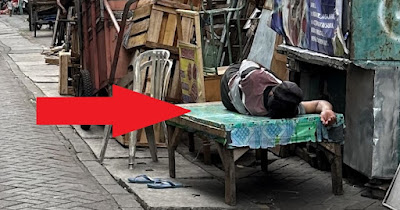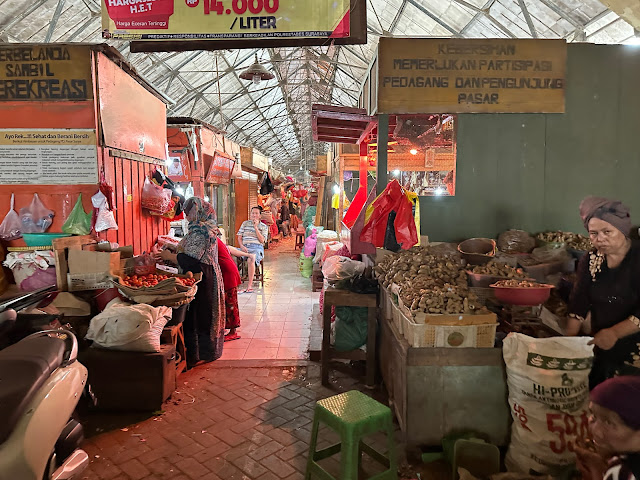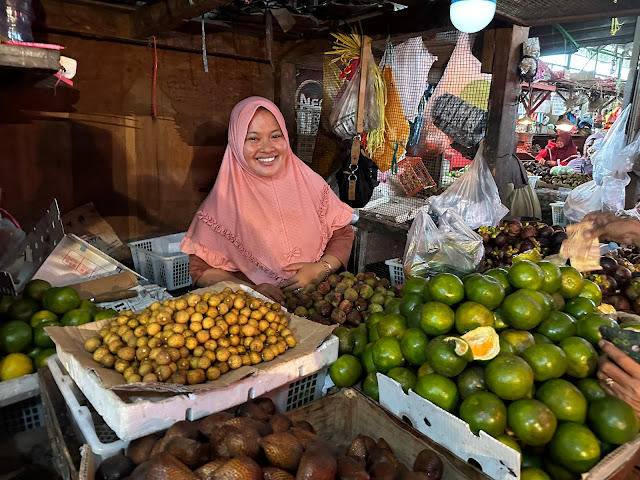July 7, 2023
We made our way out of the jungle of Borneo and to the airport in Pangkalan Bun, a small facility with just one runway. I love the blue sign below. At first I thought it was a play room for kids--a nursery--but then I realized from the image that it is a room where mothers can nurse their babies.
We flew on Nam Air, an Indoneisan regional airline based in Jakarta.
Surabaya was founded in the 10th century and is the second-largest city in Indonesia, after Jakarta. You can see Jakarta on the northwest end of Java, across from Sumatra, and Surabaya on the northeast end facing the Java Sea.
 |
| Map from Google maps |
The city proper has 2.9 million people, but the metropolitan area has 9.9 million. The Dutch East India Company established itself here in 1743. From the 18th century until the mid-20th century, Surabaya was the largest city in the Dutch East Indies. It was occupied by Japan during World War II, and then by Britain after the Japanese surrender. Surabaya gained its independence in the Battle of Surabaya in October-November 1945. More on that in the next post.
We were met by our guide Anwar and driver Iman. We made four ATM withdrawals to get a total of the equivalent of $132 US, unknowingly racking up massive fees (charged by the Indonesian banks, not our US bank) yet again.
The airport is a ways out of town, and as we drove along, Anwar pointed out a few things, like the city's biggest mosque, the Al-Akbar Mosque, but he didn't elaborate. What I know about it I learned after coming home. This is the second largest mosque in Indonesia in terms of maximum capacity and has the largest mihrab in the country.
The minaret is 99 meters tall, an ode to the 99 names of Allah.
However, this is an impressive use of a bicycle/tricycle:
So many motorcycles, just like everywhere else in Indonesia.
I have wondered in the many similar markets we have visited how the people ever sell all the food they have on display. For example, imagine how many scoops it would take to empty these bags of beans.
That's even more the case with the fresh stuff. If 20 or 30 booths are selling the same produce, how does it all get sold?
At least the peppers and garlic can hang around for a while.
Lots of garlic . . .
. . . lots of peppers.
That's mangosteen on the left, our favorite tropical fruit, and what looks like lizard-skin avocados on the right is actually salak, a palm fruit.
I asked (using gestures) this beautiful, friendly woman if I could take her photo, and she more than agreed.
However, a couple of other nearby women asked me to give them my wide-brimmed straw hat (purchased at a California Costco), and two of them actually tried to take it off my head. That was weird. I asked Anwar if my hat was inappropriate in some way, but he said no, they just liked it.
Construction of this mosque was completed in 2000. The egg-shaped dome is unlike any other on mosques we saw in Indonesia. We weren't allowed inside, but I wish our guide would have at least taken us to see the grounds.
By the way, we had left our hotel early in the morning we had only eaten a little snack at the airport, and we didn't have water with us because we had come straight from the plane. Anwar was the first guide on this trip not to have some water waiting in the car. After a couple of hours in the oppressive heat and humidity, Bob insisted that he needed something to drink, so Anwar finally had the driver go to a small store that was like a Circle K or 7-Eleven. He sent us in alone to buy our drinks. We didn't get food until we got dinner at the hotel. That is the WORST treatment we've ever had by any guide in any country, and I believe it was part of Bob's physical collapse. (More on that coming in a future post.)
We had hired Anwar to give us a tour of Surabaya, and before all the hunger and thirst drama we walked through the city's Chinatown. The street was cluttered and dirty. Note the person sleeping on a table. I think Anwar could have taken us to the dragon gate in the downtown area or to a park or to the business district, all of which I found pictures of online. Honestly, I wonder if he was prejudiced against the Chinese. The image we are left with is a person sleeping on a table rather than industry and creativity.
I'm glad I don't have to shop at this meat market. Yikes.
What is in those bags? It looks like garlic bulbs. That is a lot of garlic! They were unloading bag after bag at the Pasar Pabean, or Customs Market, our next stop
The interior of the market was a jumble of stalls, half of which seemed to be selling garlic. Actually there was one entire aisle devoted to garlic.
Markets are typically one of our favorite places to visit, but this one felt much less friendly than others we have visited. Anwar didn't stop to chat with the vendors or buy food items for us to taste. We were just foreigners, and unprofitable ones at that.
Most of the vendors were Muslim women, clothed from head to wrist to ankle, yet we were the ones sweating. I was surprised to note that many of the women had painted toenails, the favorite polish color seeming to be black!
I wasn't surprised to see a lot of dried fish. How would they keep fresh fish from spoiling in the heat and humidity?
Again, no information from Anwar, but I learned after coming home that this is also the burial place for the man who brought Islam to Indonesia, Sunan Ampel.
The indoor market spilled out onto the sidewalks, which were crowded with goods for sale and strolling shoppers.
I love this manhole cover. The buildings on it are from the Surabaya National Monument, the place we visited next.
The market seemed to have a majority of women stall-keepers, and the women did their part to stock the shelves. My neck and back could never handle this:
No wonder this woman is taking a break. This noisy, busy market is a totally different scene than the the Chinese neighborhood where we saw the man sleeping on the table.
We left the market and walked through an Arab neighborhood that seemed an economic step up from the Chinese street Anwar had taken us through.
Many of the houses had a caged bird hanging in front. Anwar didn't tell us why there were so many birds in cages, but from my reading after returning home I concluded that this street is a bird market and the birds are for sale.
We walked through the Arab market without a lot of explanation from Anwar. It would have been nice to know what some of the local products are, suggestions for authentic souvenir items, etc. It reminded me of the main market in Istanbul. Instead of pottery and pillows, however, there was a lot of clothing for sale, especially men's/boys' caps and women's dresses. I would have liked to have done a little shopping, but our guide didn't facilitate that, and I didn't really even feel comfortable taking pictures.
We came out of the market into the courtyard of Ampel Mosque. Built in 1421, it is the oldest mosque in the city.
Like most mosques, it has an ablution fountain for washing.











































The market was pretty good, although I missed the dead carcasses of a meat market. Our guide was horrible. I'm learning more about Surabaya from you and your research than I did from the guide. But I did love our hotel, I'm sure it will be featured in the next post. And for that, I like Surabaya.
ReplyDelete